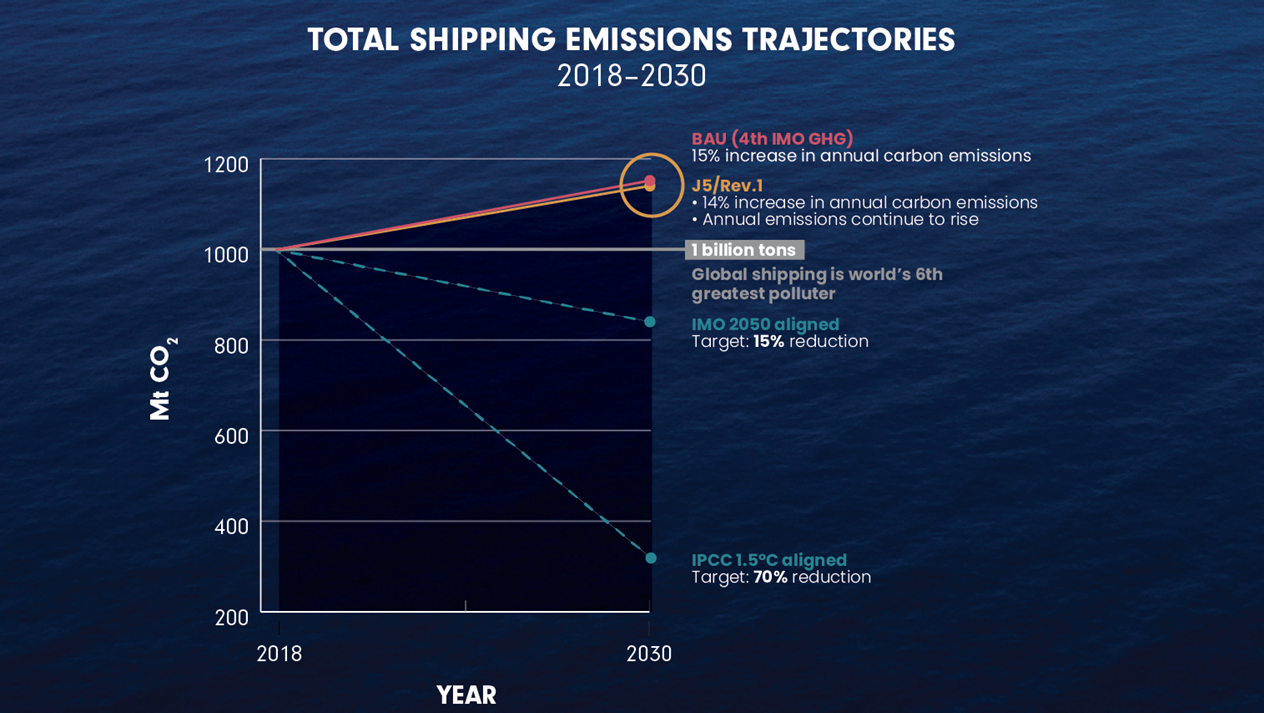UN shipping agency greenlights a decade of rising greenhouse gas emissions
This joint statement was issued by Pacific Environment, WWF and the Clean Shipping Coalition of which Ocean Conservancy is a member.
Governments have backtracked on their own commitments to urgently reduce climate-heating emissions from the shipping sector, at a key meeting of the International Maritime Organisation (IMO) held virtually this week.
The IMO’s marine environment protection committee approved a proposal that will allow the shipping sector’s 1 billion tonnes of annual greenhouse gas emissions to keep rising for the rest of this decade – the very decade in which the world’s climate scientists say we must halve global greenhouse gas (GHG) emissions to stay within a relatively safe 1.5℃ of global warming as committed to under the Paris Agreement.
“Instead of charting a course for rapid decarbonization, the IMO has moved in a dangerous direction that will allow global shipping to continue with business as usual during perhaps the most critical decade to deliver on climate action”, said Dan Hubbell, shipping emissions campaign manager for Ocean Conservancy. “We cannot afford to put off action when the evidence of climate change impacts—extreme weather events, warming waters, ocean acidification—is this clear. The IMO can and must do better than offer watered-down strategies to tackle one of the greatest global challenges of our time.”
As acknowledged by many countries in the talks, the approved proposal breaks the initial IMO greenhouse gas strategy in three crucial ways. It will fail to reduce emissions before 2023, will not peak emissions as soon as possible, and will not set shipping CO2 emissions on a pathway consistent with the Paris Climate Agreement goals.
John Maggs, President of the Clean Shipping Coalition and senior adviser to Seas at Risk said, “As scientists are telling us we have less than 10 years to stop our headlong rush to climate catastrophe, the IMO has decided that emissions can keep on growing for ten years at least. Their complacency is breath-taking. Our thoughts are with the most vulnerable who will pay the highest price for this act of extreme folly.”
Countries that supported the adoption of the proposal at IMO, and its abandonment of any effort to tackle climate change in the short term, have lost any moral ground to criticise regions or nations trying to tackle shipping emissions, as part of their economy-wide national climate plans.
Nations and regions serious about facing the climate crisis must now take immediate national and regional action to curb ship emissions. Nations should act swiftly to set carbon equivalent intensity regulations consistent with the Paris Agreement for ships calling at their ports; require ships to report and pay for their pollution where they call dock, and start to create low- and zero-emission priority shipping corridors.
The amendments to MARPOL on short-term measures on the carbon intensity of shipping, that have been approved at this session of MEPC, and put forward for adoption at the subsequent MEPC 76 session, to be held in June 2021. The MARPOL treaty requires draft amendments to be circulated for a minimum six months before adoption, and they can enter into force after a minimum 16 months following adoption.
NOTES TO EDITOR:
The Marine Environment Protection Committee meeting (MEPC75), taking place from 16-20 November, today approved a controversial policy recommendation made in October by the Intersessional Working Group on Reducing Greenhouse Gas Emissions from Ships, known as Annex 1 of ISWG-GHG7-WP.1- Rev.1, (previously called the J/5.rev1 proposal) which has three main weaknesses as a piece of regulation:
- No carbon intensity target , and a weakened Energy Efficiency of Existing Ships Index (EEXI): The proposal still contains no carbon intensity target compatible with 1.5ºC trajectory, and reduces the stringency of the required EEXI for many ship types.
- Loopholes: non-compliant ships will be able to continue underperforming for three consecutive years before they even have to file a plan to make improvements, and can easily dodge the rules and continue underperforming indefinitely by ensuring one compliant year every three years.
- No actual enforcement: All clauses that would create consequences for non-compliance – such as increased EEXI stringency, or ultimately revoking a ship’s statement of compliance – have been removed. CSC and Pacific Environment’s moderate enforcement proposal (of limiting time at sea in the following year, in proportion to non-compliance) – has been excluded.
These purposefully designed weaknesses means the proposal would, at best, now curb only 0.65% to 1.3% of GHG emissions from a business-as-usual growth pathway by 2030, according to ICCT, where the business as usual pathway is +15% above the industry’s 2008 baseline. This leaves shipping sector emissions around 14% higher in 10 years time than today.

Media Contact
Dan Hubbell
dhubbell@oceanconservancy.org